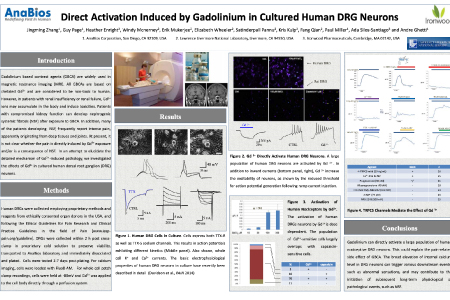PUBLICATIONS
Cross-species transcriptomic atlas of dorsal root ganglia reveals species-specific programs for sensory function
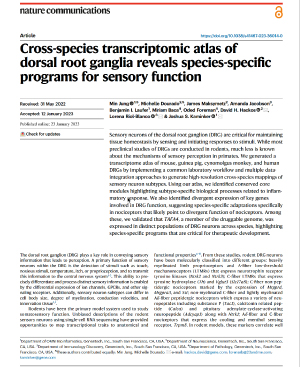
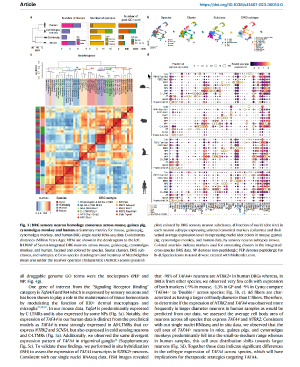
This paper (1) describes a protocol for efficient isolation of DRG nuclei from multiple species, (2) provides the high-resolution, comprehensive, detailed single-nucleus transcriptome atlas of DRG from pre-clinical to human samples, and (3) characterize the transcriptional convergence and divergence of sensory neuron subtypes from rodents to humans. Thr results reveal that DRG sensory neuron subtypes are in general well-conserved across species. However, the paper identified key differences in gene products involved in pathophysiological processes which point to the potential for species-specific sensory neuron functions. Understanding the molecular and functional similarities and differences between somatosensory neurons in rodents and primates will enable a better understanding of the role of these neurons in sensory perception and tissue homeostasis, facilitating therapeutic efforts targeting sensory neurons.
PUBLICATION: Nature Communications (2023)
AUTHORS: Min Jung, Michelle Dourado, James Maksymetz, Amanda Jacobson, Benjamin I. Laufer, Miriam Baca, Oded Foreman, David H. Hackos, Lorena Riol-Blanco & Joshua S. Kaminker
Human Sensory Neurons: Membrane Properties & Sensitization by Inflammatory Mediators


Whole-cell patch-clamp recordings from 141 human dorsal root ganglion (hDRG) neurons from five young adult donors without chronic pain were performed. The data collected indicates that most small/medium hDRG neurons can be classified as nociceptors, respond directly to compounds that produce pain and itch, and that they can be activated and sensitized by inflammatory mediators. This provides evidence that hDRG neurons can be used as a preclinical vehicle for translational target validation for chronic pain treatment.
PUBLICATION: International Association of the Study of Pain (2014)
AUTHORS: Steve Davidson, Bryan A. Copits, Jingming Zhang, Guy Page, Andrea Ghetti, Robert W. Gereau IV
The data in this paper shows how astrocytes as essential contributors to information processing and cognitive behavior. In particular, the selective expression of tetanus neurotoxin (TeNT) in astrocytes significantly reduced the duration of carbachol-induced gamma oscillations in hippocampal slices. The results support a key role for gamma oscillations in recognition memory utilizing an in vivo model.
PUBLICATION: Proceedings of the National Academy of Sciences (2014)
AUTHORS: Hosuk Sean Leea, Andrea Ghetti, António Pinto-Duartec, Xin Wang, Gustavo Dziewczapolski , Francesco Galimi, Salvador Huitron-Resendiz , Juan C. Piña-Crespoa, Amanda J. Roberts , Inder M. Verma, Terrence J. Sejnowski, and Stephen F. Heinemann
Tailoring chronic pain treatments for the elderly: are we prepared for the challenge?

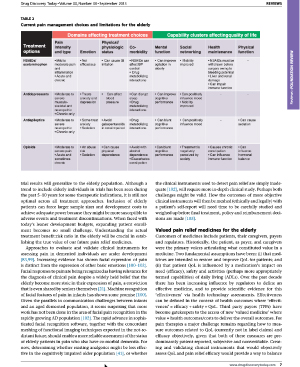
This review outlines how pain remains the number one reason patients turn to physicians for care and is recognized as a leading cause of economic burden in the US. Chronic pain in the elderly is influenced by co-morbid diseases, changes in physiological competency or cognitive reserve. Increasing life expectancy in conjunction with the aging ‘baby-boomer’ era will result in a near doubling of the elderly individual (>65 years old) population by 2030. This will result in a flooded healthcare system of individuals requiring pain relief options without an appropriate volume of optimized analgesic market drugs. A shift in the drug discovery process and renewed focus for new medications to close the gaps for pain management in later life are required.
PUBLICATION: Drug Discovery Today (2013)
AUTHORS: Stephen P. Arneric , Jennifer M.A. Laird, Amy S. Chappell and Jeffrey D. Kennedy
Chronic linaclotide treatment reduces colitisinduced neuroplasticity & reverses persistent bladder dysfunction
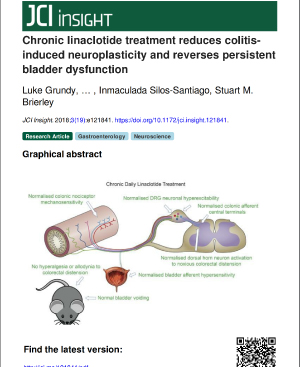
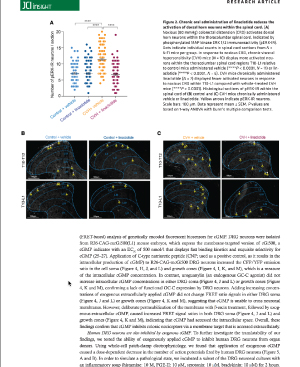
Mechanistic understanding of the cause and time course of comorbid symptoms for patients with irritable bowel syndrome (IBS) are lacking. This paper describes how colitis triggers hypersensitivity of colonic afferents, neuroplasticity of spinal cord circuits, and chronic abdominal pain, which persists after inflammation. The data supports the concepts that cross-organ sensitization underlies the development and maintenance of visceral co-morbidities, while pharmaceutical treatments that inhibit colonic afferents may also improve urological symptoms through common sensory pathways.
PUBLICATION: JCI Insight (2018)
AUTHORS: Luke Grundy, Andrea M. Harrington, Joel Castro, Sonia Garcia-Caraballo, Annemie Deiteren, Jessica Maddern, Grigori Y. Rychkov, Pei Ge, Stefanie Peters, Robert Feil, Paul Miller, Andre Ghetti, Gerhard Hannig, Caroline B. Kurtz, Inmaculada Silos-Santiago and Stuart M. Brierley
Activation of pruritogenic TGR5, MrgprA3, and MrgprC11 on colon-innervating afferents induces visceral hypersensitivity
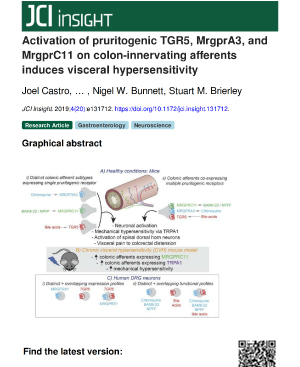
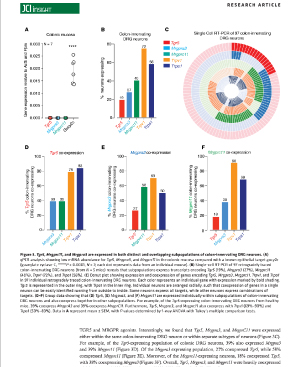
This study shows that subsets of colon-innervating sensory neurons in mice express, either individually or in combination, the pruritogenic receptors Tgr5 and the Mas-gene-related GPCRs Mrgpra3 and Mrgprc11. The in vivo intracolonic administration of these individual agonists induced pronounced visceral hypersensitivity to colorectal distention with coadministration augmenting hypersensitivity to colorectal distension and mouse behavior. The data supports the existence of an irritant-sensing system in the colon that is a visceral representation of the itch pathways found in skin.
PUBLICATION: JCI Insight (2019)
AUTHORS: Joel Castro, Andrea M. Harrington, TinaMarie Lieu, Sonia Garcia-Caraballo, Jessica Maddern, Gudrun Schober, Tracey O’Donnell, Luke Grundy, Amanda L. Lumsden, Paul Miller, Andre Ghetti, Martin S. Steinhoff, Daniel P. Poole, Xinzhong Dong, Lin Chang, Nigel W. Bunnett and Stuart M. Brierley
Long-term non-invasive interrogation of human DRG neuronal cultures on an integrated microfluidic multielectrode array platform
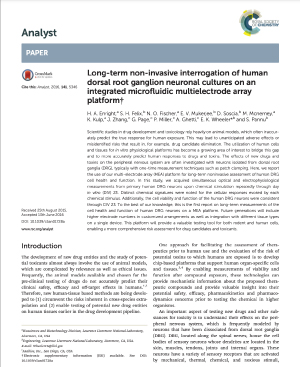
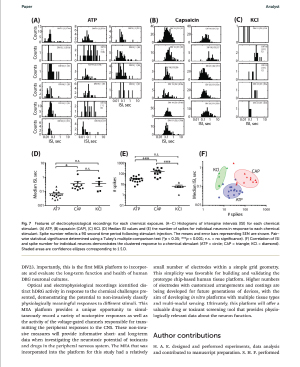
Drug development and toxicology studies rely heavily on animal models which often inaccurately predict the true response for human exposure leading to unanticipated adverse effects. This paper outlines the use of our multi-electrode array (MEA) platform for long-term noninvasive assessment of human dorsal root ganglia (hDRG) cell health and function. This first report on long-term measurement for hDRG on a MEA platform marks the way for customized arrangements as well as integration with different tissue types on a single device in the future.
PUBLICATION: Gut (2017)
AUTHORS: H. A. Enright, S. H. Felix, N. O. Fischer, E. V. Mukerjee, D. Soscia, M. Mcnerney, K. Kulp, J. Zhang, G. Page, P. Miller, A. Ghetti, E. K. Wheeler and S. Pannu
RESEARCH POSTERS
Carbamazepine and CNV 1427400 Exhibit Similar Pharmacology in Rat and Human Native DRGs

Whole cell patch-clamp electrophysiology was used to investigate the in vitro properties of Carbamazepine and CNV1427400, a novel sodium channel blocker, in human recombinant sodium channels, rat DRGs and human native DRGs from health donors. The human native and recombinant Navs, Carbamazepine and CNV1427400 show similar potency and state-dependent mechanism of block, translating into a similar frequency-dependent inhibition of action potential firing in rat and human native DRGs.
AUTHORS: S.N. Tate, F. Rugiero, D. Derjean. V.A. Panchenko, D. Owen, A. Ghetti, K. Bannister, M. Thakur, A.H. Dickenson, P. Miller, V. Morriset
Extracellular Cyclic GMP (cGMP) Reduces Excitability of Murine and Human Dorsal Root Ganglion Neurons

In a subpopulation of colonic DRG neurons from mice, cGMP inhibited the neuronal excitability of putative nociceptors, significantly increasing their rheobase and reducing action potential discharge. In human DRG neurons, cGMP induced an overall reduction in the number of cells responding to hypo-osmotic stimulation. These results complement previous demonstrated finding that cGMP inhibited the peripheral endings of nociceptors within the wall of the colon.
AUTHORS: Joel Castro, Grigori Y. Rychkov, Andrea Ghetti, Andrea M. Harrington, Caroline Kurtz, Ada Silos-Santiago and Stuart M. Brierley
In this study, we report a new approach for studying the phenotypic profile of human DRG neurons in culture, based on the responses to electrical field stimulation, chemical irritants (capsaicin and AITC) and cold buffer. This methodology provides valuable tools for studying the properties of human sensory neurons and for investigating the activity of new analgesic drugs in the context of pathological states.
AUTHORS: Jingming Zhang, Yannick Miron, Guy Page, Bryan Copits, Steve Davidson, Paul Miller, Robert W. Gereau, IV and Andre Ghetti
High-content functional imaging reveals differential effects of inflammation on two distinct populations of human nociceptive neurons
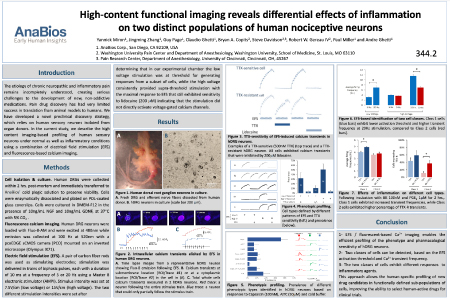
In this study, we describe the high content imaging-based profiling of human sensory neurons under normal and inflammatory conditions using a combination of electrical field stimulation (EFS) and florescence-based calcium imaging. This approach allows the human-specific profiling of new drug candidates in functionally defined sub-populations of cells, improving the ability to select human-active drugs for clinical trials.
AUTHORS: Yannick Miron, Jingming Zhang, Guy Page, Claudio Ghetti, Bryan A. Copits, Steve Davidson, Robert W. Gereau IV, Paul Miller and Andre Ghetti
Gadolinium based contrast agents are widely used in MRIs and are all based on chelated Gd3+. This study attempts to elucidate the detailed mechanism of Gd3+-induced pathology by investigating the effects of Gd3+ in cultured hDRG neurons. The study found that Gadolinium can directly activate a large population of human nociceptive DRG neurons.
AUTHORS: Jingming Zhang, Guy Page, Heather Enright, Windy Mcnerney, Erik Mukerjee, Elizabeth Wheeler, Satinderpall Pannu, Kris Kulp, Fang Qian, Paul Miller, Ada Silos‐Santiago and Andre Ghetti
TRPM8-mediated response to cold in human DRG neurons & modulation by the chemotherapy agent oxaliplatin

Cold allodynia is often experienced by individuals with chemotherapy-induced peripheral neuropathy (CIPN). This study monitored immunoreactivity of TRPM8, a prime candidate for the transduction of low temperature-induced pain, in human DRGs. It found that TRPM8 may significantly contribute to the reported cold allodynia.
AUTHORS: Andre Ghetti, Jingming Zhang, Yannick Miron, Jennifer Stretton, Kerrie Morrison, Paul Murdock, Keith Page and Paul E Miller
Biophysical and Pharmacological Characterisation of Native Human Nav1.8 Channels from Isolated DRG

The Nav1.8 TTX resistant (TTX-r) voltage-gated sodium channel was characterized from human DRG and pharmacologically proven using a selective blocker. Under the small dataset and recording conditions it was shown both biophysically and pharmacologically that Nav1.8 is present and functional in human DRG and that the properties of recombinant hNav1.8 channels expressed in a variety of neuronal and non-neuronal backgrounds closely resemble those of the native channel.
AUTHORS: Liz Payne, Victor A. Panchenko, Andrea Ghetti, Ari Alexandrou, Paul E. Miller, Edward Stevens
Sensory Neuron Hyperexcitability Is Prevented by Group 2 Metabotropic Glutamate Receptors in Mouse and Human

Expression of metabotropic glutamate receptor 2 (mGlu2) was studied in mouse and human DRGs. The mGlu2 activation or potentiation of endogenous activity was found to prevent and reverse indicators of pain. mGlu2 immunoreactivity is present in medium sized DRG neurons.
AUTHORS: Steve Davidson, Judith P. Golden, Guy Page, Jingming Zhang, Andrea Ghetti, and Robert W. Gereau IV
Human Sensory Neurons: Excitability, Sensitization and Multiple Potassium Channel Conductances

Over 150 human DRG neurons were recorded in vitro in an attempt to characterize their electrophysiological profiles, whether they respond to noxious chemicals and inflammatory mediators that can induce peripheral sensitization and explore the possibility of blocking sensitization in hDRG neurons with a pharmacological approach targeting group II metabotropic glutamate receptors. Target validation in these human sensory neurons can enhance analgesic discovery and can respond to AITC, ATP, histamine and chloroquine indicating a robust chemosensitivity that may exceed that of rodents.
AUTHORS: Steve Davidson, Bryan A. Copits, Jingming Zhang, Guy Page, Andrea Ghetti and Robert W. Gereau IV
Identification of a selective voltage gated sodium channel blocker able to preferentially inhibit human DRG neurons sensitized by inflammatory agents

This study identified a novel potential therapeutic, ANB-504, utilizing our human-focused discovery paradigm. ANB-504 inhibits the activation of human sensory neurons in pathological states and had undetectable effect on the human cardiac action potential with an excellent safety margin to cardiac contractility risk.
AUTHORS: Andre Ghetti, Anh Tuan Ton, Yannick Miron, Phachareeya Ratchada, Nathalie Nguyen, Ashley Alamillo, William Nguyen, Katrina Sweat, Brynna Nguyenton, Tim Indersmitten, Guy Page, Paul Miller, Najah Abi-Georges and Jack Reynolds
Ex Vivo Human Models of Inflammatory & Neuropathic Pain States for Enabling Translational Research & Drug Discovery

By adding proinflammatory or neuropathogenic agents to DRG culture conditions, this study investigated how the physiological properties of cells are altered in our pain models. The successful establishment of our human ex vivo models for inflammation and chemotherapy-induced neuropathy are powerful tools to predict the therapeutic efficacy of lead compounds under specific pain conditions.
AUTHORS: Andre Ghetti, Yannick Miron, Anh-Tuan Ton, Tim lndersmitten, Nathalie Nguyen, Phachareeya Ratchada, Ashley Alamillo, Katrina Sweat, Ismael Tapia, Guy Page and Paul Miller




